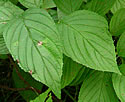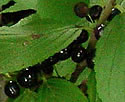Rhamnus alnifolia (Alder-leaved Buckthorn)
| Also known as: | Dwarf Alder, American Alder Buckthorn |
|---|---|
| Genus: | Rhamnus |
| Family: | Rhamnaceae (Buckthorn) |
| Life cycle: | perennial woody |
| Origin: | native |
| Habitat: | part shade; moist, shady bogs, fens, lake edges |
| Bloom season: | May - June |
| Plant height: | 2 to 3 feet |
| Wetland Indicator Status: | GP: FACW MW: OBL NCNE: OBL |
| MN county distribution (click map to enlarge): |  |
| National distribution (click map to enlarge): |  |
Pick an image for a larger view. See the glossary for icon descriptions.
Detailed Information
Flower: 

![[photo of flowers]](/udata/r9ndp23q/pd3/rhamnus-alnifolia-6-t.jpg) Flowers are small, ¼ inch or less across, yellowish green, 5 pointed and star-like, short stalked, in clusters of 1 to 3 in the leaf axils of new growth. There are no petals, the triangular star points are sepals set around a flattened, saucer like recepticle. Male and female flowers are on separate plants, the male flowers with 5 yellowish stamens surrounding a green center, females with a 3-parted style in the center.
Flowers are small, ¼ inch or less across, yellowish green, 5 pointed and star-like, short stalked, in clusters of 1 to 3 in the leaf axils of new growth. There are no petals, the triangular star points are sepals set around a flattened, saucer like recepticle. Male and female flowers are on separate plants, the male flowers with 5 yellowish stamens surrounding a green center, females with a 3-parted style in the center.
Leaves and bark: 

![[photo of leaf]](/udata/r9ndp23q/pd3/rhamnus-alnifolia-13-t.jpg) Leaves are simple and alternate, oval or oblong lance-elliptic, 2 to 4½ inches long and ¾ to 2¼ inches wide, the edges with rounded teeth, with or without glands in the serrations, and 5 to 8 veins per side. The upper surface is darker green, appearing shiny or with sparse hairs; the lower surface is lighter green with hairs typically present.
Leaves are simple and alternate, oval or oblong lance-elliptic, 2 to 4½ inches long and ¾ to 2¼ inches wide, the edges with rounded teeth, with or without glands in the serrations, and 5 to 8 veins per side. The upper surface is darker green, appearing shiny or with sparse hairs; the lower surface is lighter green with hairs typically present.
![[photo of stipules]](/udata/r9ndp23q/pd3/rhamnus-alnifolia-7-t.jpg) At the base of the leaf stalk of new growth is a pair of narrow, leafy appendages (stipules). Main branching stems are horizontally spreading, typically less than 1 inch in diameter at the base with thin, roughish red-brown to gray bark. Side branches are erect, spindly, and thornless. New growth is green or brownish with minute hairs turning grayish brown the second year.
At the base of the leaf stalk of new growth is a pair of narrow, leafy appendages (stipules). Main branching stems are horizontally spreading, typically less than 1 inch in diameter at the base with thin, roughish red-brown to gray bark. Side branches are erect, spindly, and thornless. New growth is green or brownish with minute hairs turning grayish brown the second year.
Fruit: 
![[photo of fruit]](/udata/r9ndp23q/pd3/rhamnus-alnifolia-18-t.jpg) Fruit is a short-stalked, shiny, black berry up to 1/3 inch in diameter, with 1 to 3 seeds inside. The berry is often irregularly slightly lobed with a faint groove on the surface between each seed.
Fruit is a short-stalked, shiny, black berry up to 1/3 inch in diameter, with 1 to 3 seeds inside. The berry is often irregularly slightly lobed with a faint groove on the surface between each seed.
Notes:
For all the negative press that buckthorns get, many people are surprised that Minnesota has a native buckthorn. While fairly widespread and common within its preferred habitats across the northern 2/3 of the state, as you'd expect with native species it is not invasive at all. It does produce a fruit with viable seeds that are likely eaten and spread by wildlife, but co-evolved factors limit its introduction and spread across the broader environment. A primary means of reproduction is by a process called “layering”, where the horizontal stems and branches produce roots, creating expanding colonies up to 50 feet across. The root/branch structures of these colonies may become disconnected over time producing genetically identical but independently functioning individuals within the colony. This native can be distinguished from the invasive non-native buckthorns by its short stature (3 feet or less at maturity), the obvious stipules at the base of the leaf stalk, 5-parted flowers, and leaves with rounded teeth and 5 to 8 veins per side. Glossy Buckthorn (Frangula alnus) has toothless leaves with 6 to 9 veins per side, and Common Buckthorn (Rhamnus cathartica) has 4-parted flowers and leaves with rounded teeth and only 3 or 4 veins per side. Both of the non-natives grow significantly taller and bushier than Alder-leaved Buckthorn, and their clusters have much more than 3 flowers and produce far more fruit.
Native Plant Nurseries, Restoration and Landscaping Services ↓
More photos
 Alder-leaved Buckthorn plant
Alder-leaved Buckthorn plant Alder-leaved Buckthorn habitat
Alder-leaved Buckthorn habitat more leaves
more leaves Alder-leaved Buckthorn plants
Alder-leaved Buckthorn plants fall color
fall color more flowers
more flowers
Photos courtesy Peter M. Dziuk taken in Aitkin, Becker, Lake and St. Louis counties.
Comments
Have you seen this plant in Minnesota, or have any other comments about it?
on: 2016-08-15 09:21:45
I have a jungle in my backyard. I have read and reread on Buckthorn and have not torn anything up because not sure what is good or bad. I am pretty sure I have Black Chokecherry, but also something similar. Maybe one of the invasive Buckthorns, but maybe it is the native one. What is the best time of year to identify? On a good note, it's also like a bird sanctuary out there.
on: 2016-08-15 10:53:43
Luciearl, the invasive buckthorns will be green into October and even November, which is why "buckthorn busts" are usually held in fall - whatever is still green is probably bad. See the other buckthorn profiles for other identifying information. As for the native buckthorn, the county distribution map shows it's not known to be present in your area.
on: 2017-01-08 21:17:00
Is it possible to get some close up photos of the bark and buds? This could help with winter id for those that treat it.
on: 2019-12-12 09:57:11
I have a small colony of R. alnifolia along my woodland edge and it would be very difficult to confuse it with the invasive buckthorn species. It's comparatively diminutive and very slow spreading. It more closely resembles some of our other native shrubs in appearance and behavior.
on: 2021-05-09 12:07:04
Is Rhamnus alnifolia the only buckthorn with stipules? The article is not clear about this. I have found quite a lot of buckthorn which has stipules like in the picture above, but the leaves are otherwise as described for R. cathartica. Are these interspecific hybrids?
on: 2021-05-09 13:23:49
Ellen S., if you're unsure, I would not count on that single characteristic to make a determination. If the leaves more closely resemble one of the invasive buckthorns, then that is probably what you have. There are no buckthorn hybrids documented in Minnesota.
on: 2023-01-10 08:55:52
I've been keeping an eye out for buckthorn in my neighbor's yard but I wasn't aware that there is a native species. Is the Alder-leaf B. available for sale and, if so, what are the pros and cons of plant in a (large) metro yard? Thanks.
on: 2023-01-10 09:36:25
Tom, we don't track who sells what, but Outback Nursery in Hastings probably has the largest selection of native trees and shrubs. In any case, it's a pretty short and spindly shrub and may or may not do well in a residential landscape. Also, see the Notes above about how it spreads.
on: 2024-02-07 13:54:01
I had a patch of R. alnifolia along a woods edge in Winona County. It stayed a lot shorter than the invasives, spread by layering so that may help with id. I am looking for information on how it was used medicinally and by whom, in Minnesota. Wabasha branch of Dakota? Might that explain it being in Wabasha and Winona Counties? Thankyou.
on: 2024-02-07 15:28:58
Lea, Minnesota Wildflowers doesn't have any information on how this plant may have been used medicinally.






